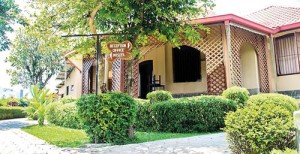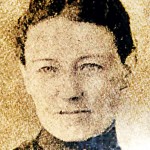It all began for a coterie of Kandyan chiefs’ daughters
“Our Father, by whose servants, our house was built of old…” the lines of the old hymn go.
Hillwood College, Kandy, celebrates its 125th anniversary today, Hillwood Sunday. The school’s founder, Miss Elizabeth Bellerby was the first missionary sent to Sri Lanka by the Church of England Zenana Missionary Society (CEZMS). She arrived in 1889 with the intention of setting up a school for the daughters of the “caste-conscious and extremely conservative” Kandyan chiefs of the island. After a few months spent learning Sinhala at Kotte, she made her way to Kandy, bought over Hillwood bungalow, and with seven students, set up the school on May 15, 1890.
Lena Augusta Chapman: Raising a legacy
Probably the most influential and inspiring person in the history of Hillwood College is Miss Lena Augusta Chapman. Her progressive thinking, courage, hard work and commitment to serving the community provided the framework within which the school grew, on the foundations that Bellerby had laid.

Clarence House: The original Hillwood bungalow. Pix by Ashwin Dominique Jayalath
Chapman served in apprenticeship as assistant to Bellerby for ten years, until the latter returned to England in 1911. This training probably gave her the opportunity to understand the workings and particular challenges of the situation before she took on the responsibility of leading the school to great progress, both academically and structurally, during her tenure as Principal.
In 1913, Chapman took her first controversial step with the school, by admitting non-Kandyan day-scholars to Hillwood. Though aristocratic parents were not happy, the young Principal stood her ground, and the change was slowly but surely accepted.
The school continued to be primarily a boarding school for many years afterwards, and Chapman’s next problem was that the girls spent most of their term-time confined to the premises of the school. Their only travels abroad were to the Royal Botanical Gardens at Peradeniya and St. Paul’s Church on the weekend, in a well-covered bullock cart intended to prevent the young aristocratic ladies from “making an exhibition of themselves”. The carts would sometimes get stuffy on the considerable journey to Peradeniya, and Chapman decided to modify their coverings, turning them into adjustable curtains through which the occupants of the vehicle could take a peek at the road. Needless to say, the more adventurous girls probably took the opportunity to take in the “scenery” of fashionable young men abroad on the weekend, and their parents unhappily called the Principal “too modern” for their girls.

Founder principal Elizabeth Bellerby
Undeterred, Chapman continued to encourage the girls to push the boundaries of their lifestyle, introducing games and a tennis court to Hillwood. She was mindful of the Kandyan tradition which the school was pledged to protect though, and the girls played in their traditional ankle-length costumes, with their hair in a “konde” while their contemporaries played in shorter European dresses. This juxtaposition of the old and new, the modern and the traditional, the progressive and the conservative is even now an integral part of the school’s identity, and didn’t hold Chapman’s girls back. On the contrary, by the time Hillwood celebrated its 25th anniversary in 1915, its students were award-winning tennis and netball players, and regular recipients of the Junior and Senior Cambridge certificates.
The spiritual growth of the teachers and students at Hillwood was also something Lena Chapman was concerned about. While foraying into sports and better academic performance, she also raised funds for a chapel for the school. Building began in 1921, and by October 28, 1922, Hillwoodians had their own place of worship.

Principal Sudarshani Hettige
At the same time, Chapman also set things in motion for an “Old Girls’ Association” (OGA) to be formalized. By 1926 the OGA was well established and able to support long-term projects, mainly a “Free Sinhalese School” for girls from the neighbourhood who were not as privileged as those admitted to Hillwood. In 1930, with government support, this school was moved to new premises. Now named “Evelyn Nurseries” after Chapman’s sister who played a major role in making the project possible, the school provides care for an average of 40 destitute girls, creating an opportunity and tradition for past pupils to engage in meaningful social service and give back to their alma mater.
“[Chapman’s] achievement was to follow on Miss Bellerby’s pioneer work and to be a builder,” Soma Samarasinhe, a later Principal wrote of Lena Chapman, “a builder not only of edifices of brick and mortar of which she put up many, but that of ideals, traditions, standards and character.”
Chapman retired in 1931, succeeded by Mary Dorothy Rigg. War broke out in 1939, and jubilee celebrations in 1940 were much more subdued than the school had been planning for, over two years. The first school magazine, designed by Premi Halangoda and edited by Lois Peiris and Sumithra Panabokke, was published for the occasion, and Chapman who was in failing health by this time nevertheless presented a glorious report of Hillwood’s achievements over its first half century.

Vice Principal Nelum de Alwis
Just over a year later, on May 31, 1941, she bade the earth goodbye.
Miss Chapman’s ashes were laid beneath the altar of the school chapel.She had continued to serve Hillwood at the Evelyn Nurseries, after her tenure as Principal, and seen the school through 40 of its 50 years in existence, offering, as the motto goes, her “Utmost for the Highest”. The path she cleared for her students, for questioning cultural norms while nurturing and supporting the society they lived within, are still the bedrock of Hillwood’s values.
Without Chapman’s guidance, Mary Dorothy Rigg was now left to venture out on her own.
The Ceylon University College was established in 1921, and although Hillwood was already three decades old at the time, not a single of its students had ventured to pursue higher education. So when the University of Ceylon was established at Peradeniya in 1942, Rigg set her sights on steering Hillwood towards further education. In 1943, she set up classes for the university entrance examination, and Hillwood celebrated another academic milestone when in 1946 Sumithra Panabokke passed the London Matriculation and was offered a place at the University of Ceylon.
Rigg unfortunately did not live to see the fruition of her efforts. On a long overdue vacation in 1944, she was tragically “lost at sea” on her way to England when the ship she was travelling in was torpedoed. “Safe rest they in Thy keeping, Who changest not with years” would have had new meaning for the young girls singing their school hymn.
Ms. Eleanor Foss had been appointed Acting Principal for the expected period of Rigg’s absence. When the time drew near for her departure, the post of Acting Principal at Hillwood College was advertised. Ceylon was in the very real expectation of independence by this time, and the then Principal at St. Thomas’ Girls’ High School in Matara, a Kandyan by birth, was encouraged to apply. It was considered suitable that in the event of independence, a Ceylonese was at the helm of one of the most prestigious women’s education institutions in the country.
The daughters of Kandy
Soma Kumari Samarasinha was appointed Acting Principal in 1946, and Principal in 1947. She was the first Sri Lankan to hold this position at Hillwood.
What she found upon assuming duties was “a well-organized girls’ boarding school…built on the priceless traditions of Christian sacrificial service, hard work, and the dignity and nobility of womanhood”. A house and prefect system had trained the students for self-government, games and extra-curricular activities, the school magazine was now an annual feature, and the OGA was well established to inculcate a strong tradition of social service and concern for the less fortunate.
But not everything was perfect. “The upheaval of the war years and the shock caused by the sudden loss of the principal had introduced a certain lowering of standards and a loss of grip, as it were,” Samarasinha wrote of her first impressions.
In 1950, Samarasinha was faced with probably the toughest decision an administrator at Hillwood College has had to face. The post-independence government demanded that the board decide whether they would become a “free-school” or continue to charge fees and forego state aid. Despite having spent only a few years at the school, Samarasinha recognized its distinctive strengths and their link to the fact that it was a boarding school with small numbers. Thus, despite some unease with the decision, in April 1951 Hillwood declared itself an independent “private” school. Some students were pulled out and a few teachers left, but with the years, Samarasinha was convinced that “the decision was a wise one and the right one for Hillwood”.

The beginnings: Hillwood’s first students and teachers with the Principal and Rev. Ireland Jones
To posterity, she became known as “the great builder”. The long envisioned Chapman Memorial Hall (1955), the extensions to the dining hall and accompanying kitchen and staff quarters as well as extensions to the Principal’s Bungalow (1956), new sewerage systems and toilet facilities (1957), the Rigg memorial science building (1960), development of the main roadway up to the college and a retaining wall along the stream at the west boundary of the premises (1960-1962) and the Cave Memorial Hostel and nursery buildings as well as the school’s central library (1963) were all put during Samarasinha’s tenure.
It was much later, at her resignation after 17, nearly 18 years of service to the school, that Samarasinha was ready to achieve her dream.
“It is my fervent hope,” she said, in her first address at Hillwood, “that this is prophetic of the day when Kandyan women in ever-increasing numbers will take their due place in positions of responsibility and national service. It is prophetic too I hope of the day when the alumni of this school, trained and qualified for the task, will take the responsibility of guiding its destinies to the greater Glory of God.”
January 1964, Miss Barbara de Alwis, an old girl of Hillwood College, became the first past pupil Principal. Samarasinha proudly left her in charge, in the hope that, “nurtured in the traditions of the school from her earliest days,” de Alwis would be “pledged to guard them jealously against the changes and chances of the present time and the future.”
After de Alwis, Nimalathevi Perera took the reins, and in 1990, Hillwood College celebrated its centenary year with Sumithra Ratnayake as its new Principal, leading the school.
The current Principal, Sudarshani Hettige, took over in 2008. With Vice Principal Nelum de Alwis, she has nurtured the expansion of Hillwood’s achievements in academics, sports, international linkages and infrastructure. Today the school records nearly perfect pass rates at milestone exams.
“The challenge for us now is that the parents of our students – not the students mind you – are becoming academically competitive as the national educational environment changes,” points out Vice Principal de Alwis. “Our academic performance has improved significantly in the last few years, but that is not our focus. We want the girls to understand that a balanced perspective will take them further.”
And although a past pupil stepping in to the school will find that much has changed structurally in the recent past, one sees the hints of a modern, progressive campus for women in the making: an echo, one hopes, of the forward-thinking patterns set by the predecessors Bellerby and Chapman.
As students (now over a thousand), staff and well-wishers of Hillwood celebrate this important milestone in its history, the words of the school hymn are their prayer:
“The days of old hath dowered us, with gifts beyond all praise; Our Father, make us faithful to serve the coming days.”


